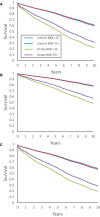Overweight, Obesity, and Survival After Stroke in the Framingham Heart Study
- PMID: 28647687
- PMCID: PMC5669145
- DOI: 10.1161/JAHA.116.004721
Overweight, Obesity, and Survival After Stroke in the Framingham Heart Study
Abstract
Background: We investigated how body weight affects survival after stroke, leveraging the availability of multiple prestroke body mass index (BMI) measurements and using a nested case-control design in a community-based sample.
Methods and results: We compared all-cause mortality in participants stratified by prestroke weight. Separate analyses were performed for ischemic stroke and all stroke and for age-, sex-, and BMI category-matched stroke-free controls. Participants were grouped into BMI categories and followed for up to 10 years. Differences in survival were tested for interaction by case status. In sensitivity analysis, to exclude those with prestroke weight loss, we restricted the reference group to participants with 2 consistently normal BMI measurements within 10 years before stroke/matching. There were 782 stroke cases (age 71±9, 51% female participants, 87% ischemic stroke) and 2346 controls (age 72±9, 51% female participants). Overweight participants with ischemic stroke had a lower mortality compared with those with normal weight (hazard ratio [HR]=0.70, 95%CI 0.55-0.90, P=0.005). The association of reduced mortality with BMI ≥25, compared with normal-weight BMI 18.5 to <25, was pronounced among ischemic stroke cases but diminished with inclusion of hemorrhagic strokes (case-control interaction P=0.051 and P=0.130, respectively). Compared with participants with stable normal weight, moderately increased weight was protective after ischemic stroke (overweight HR=0.72, 95%CI 0.53-0.99, P=0.041).
Conclusions: Overweight and mildly obese participants had better 10-year survival after ischemic stroke compared with normal-weight participants, even after excluding persons with recent prestroke weight loss. There may be unknown protective factors associated with a moderately increased body weight before stroke.
Keywords: body mass index; body weight; cerebrovascular disease; epidemiology; mortality; obesity; recurrent event; risk factor; secondary prevention; stroke.
© 2017 The Authors. Published on behalf of the American Heart Association, Inc., by Wiley.
Figures

References
-
- Mozaffarian D, Benjamin EJ, Go AS, Arnett DK, Blaha MJ, Cushman M, de Ferranti S, Despres JP, Fullerton HJ, Howard VJ, Huffman MD, Judd SE, Kissela BM, Lackland DT, Lichtman JH, Lisabeth LD, Liu S, Mackey RH, Matchar DB, McGuire DK, Mohler ER III, Moy CS, Muntner P, Mussolino ME, Nasir K, Neumar RW, Nichol G, Palaniappan L, Pandey DK, Reeves MJ, Rodriguez CJ, Sorlie PD, Stein J, Towfighi A, Turan TN, Virani SS, Willey JZ, Woo D, Yeh RW, Turner MB; American Heart Association Statistics Committee and Stroke Statistics Subcommittee . Heart disease and stroke statistics–2015 update: a report from the American Heart Association. Circulation. 2015; 131:e29–e322. - PubMed
-
- Carandang R, Seshadri S, Beiser A, Kelly‐Hayes M, Kase CS, Kannel WB, Wolf PA. Trends in incidence, lifetime risk, severity, and 30‐day mortality of stroke over the past 50 years. JAMA. 2006;296:2939–2946. - PubMed
-
- Kurth T, Gaziano JM, Berger K, Kase CS, Rexrode KM, Cook NR, Buring JE, Manson JE. Body mass index and the risk of stroke in men. Arch Intern Med. 2002;162:2557–2562. - PubMed
-
- Meschia JF, Bushnell C, Boden‐Albala B, Braun LT, Bravata DM, Chaturvedi S, Creager MA, Eckel RH, Elkind MS, Fornage M, Goldstein LB, Greenberg SM, Horvath SE, Iadecola C, Jauch EC, Moore WS, Wilson JA; AHA Stroke Council, Council on Cardiovascular and Stroke Nursing, Council on Clinical Cardiology, Council on Functional Genomics and Translational Biology, Council on Hypertension . Guidelines for the primary prevention of stroke: a statement for healthcare professionals from the American Heart Association/American Stroke Association. Stroke. 2014;45:3754–3832. - PMC - PubMed
MeSH terms
Grants and funding
LinkOut - more resources
Full Text Sources
Other Literature Sources
Medical

